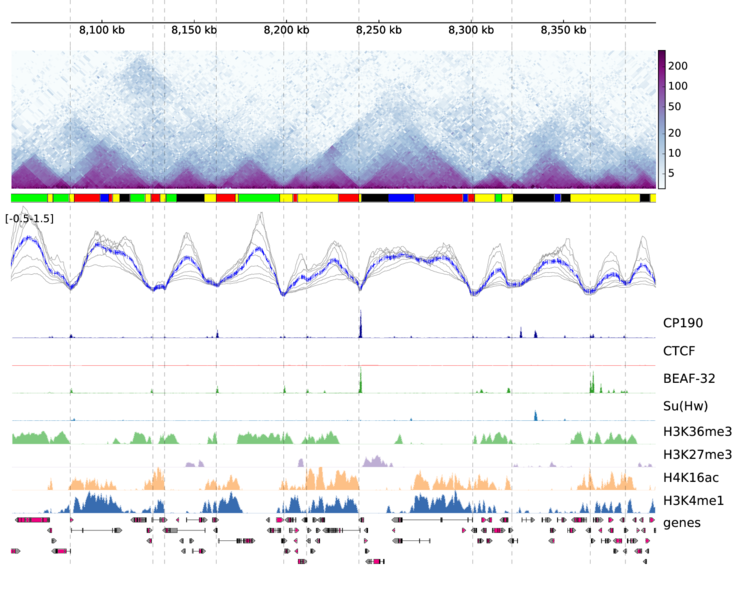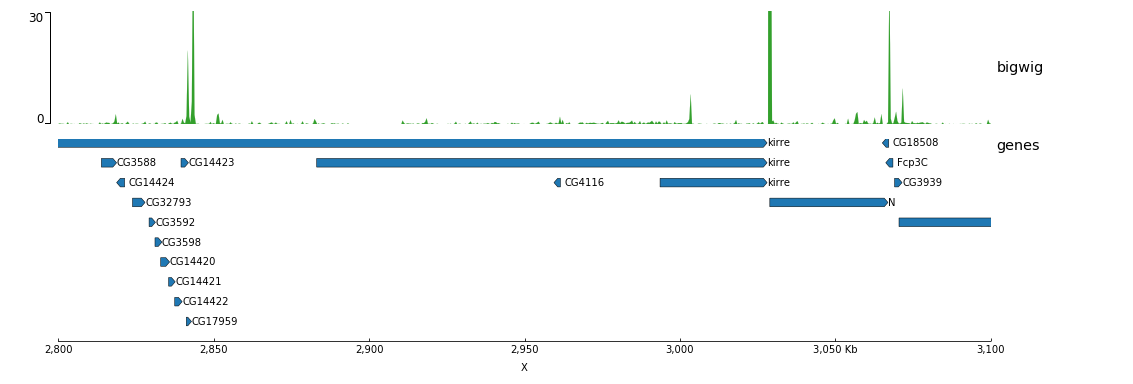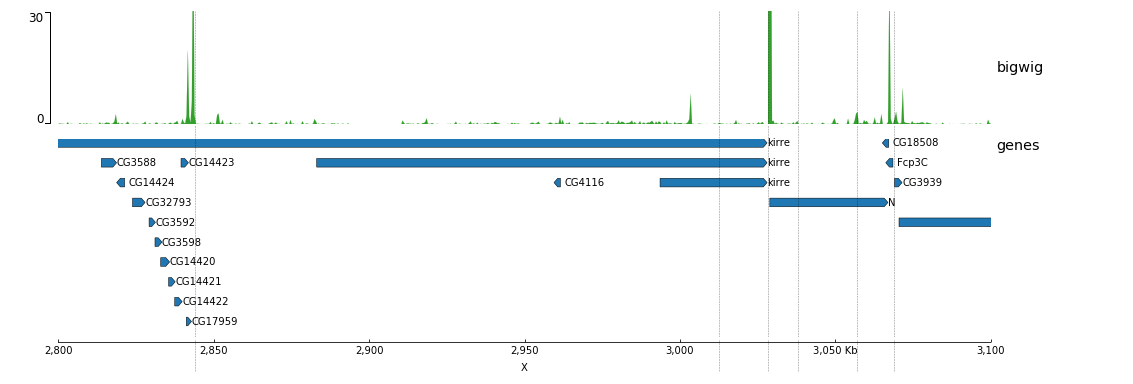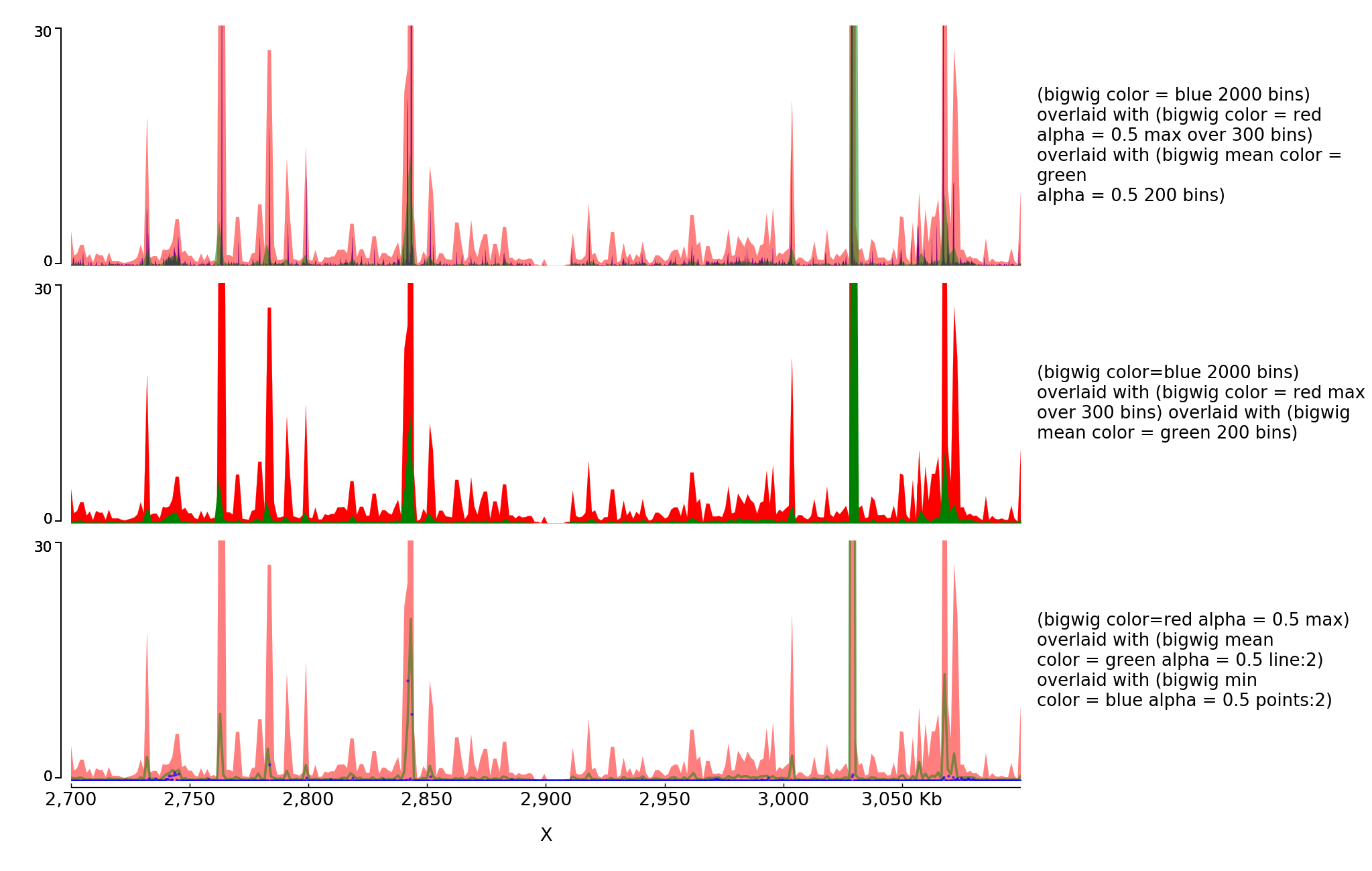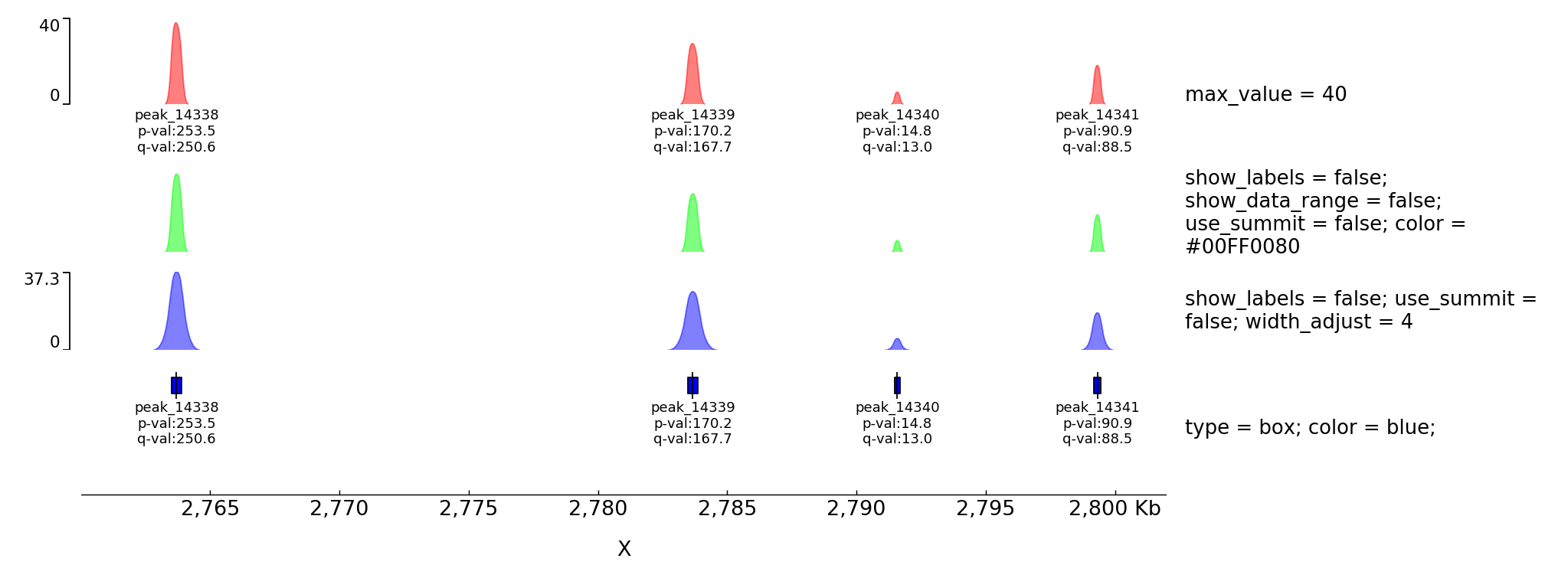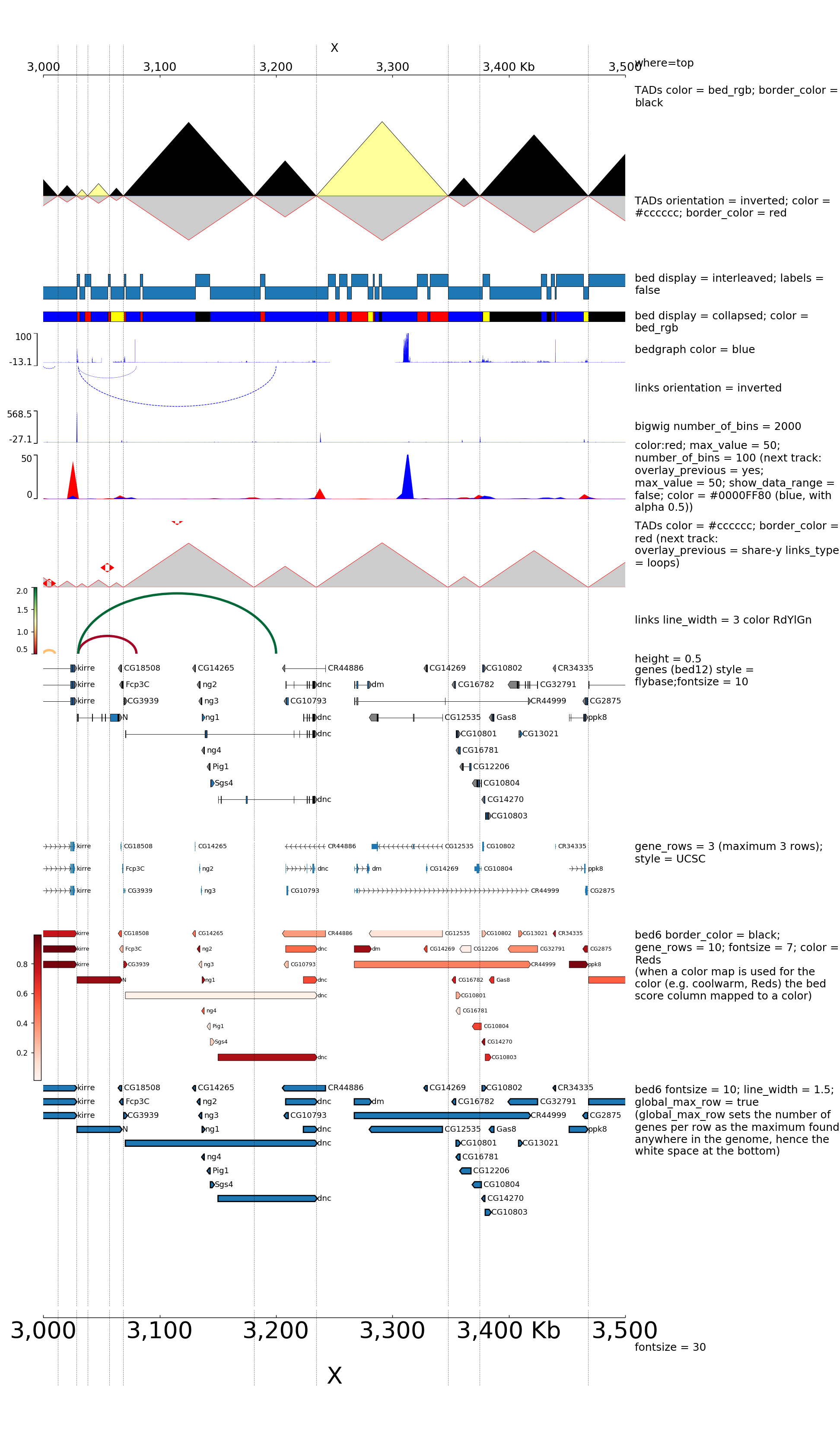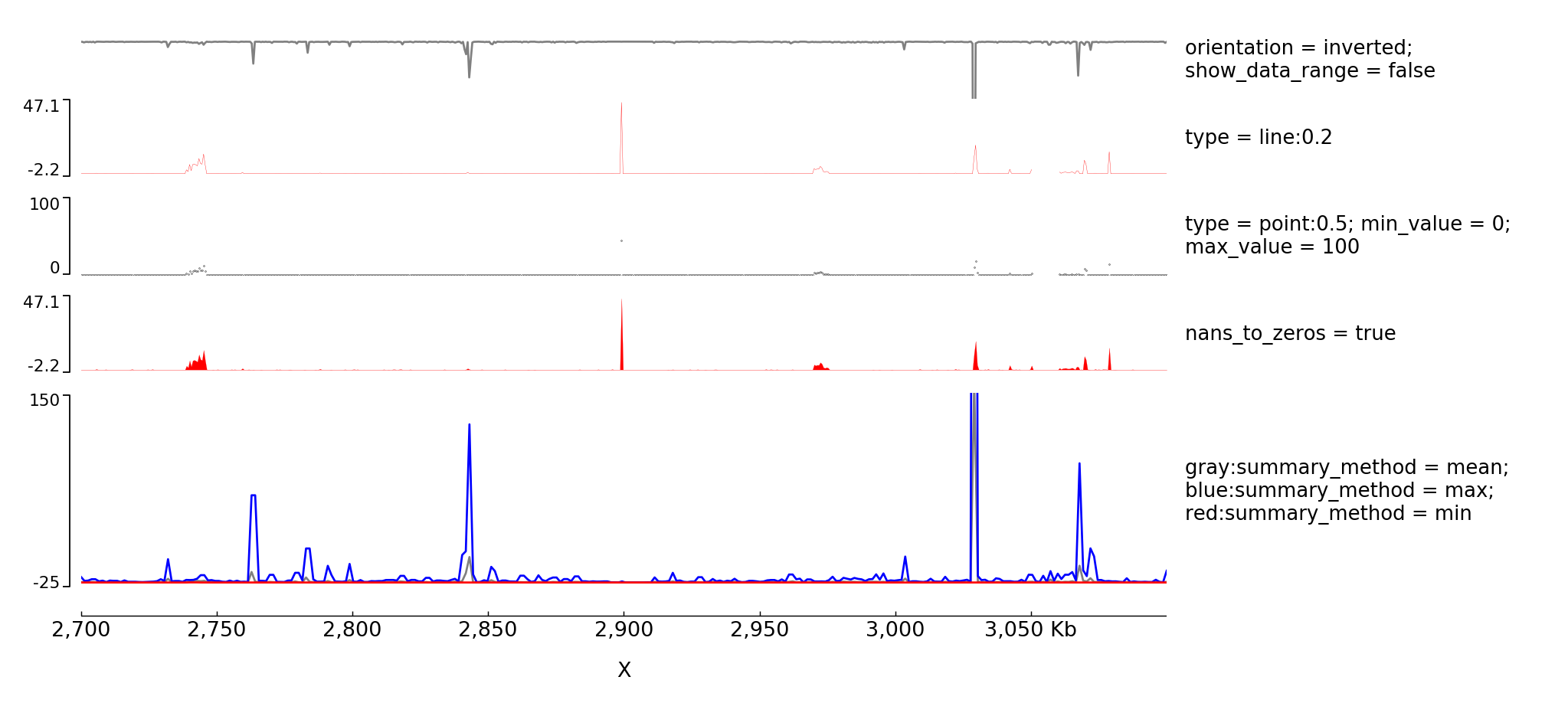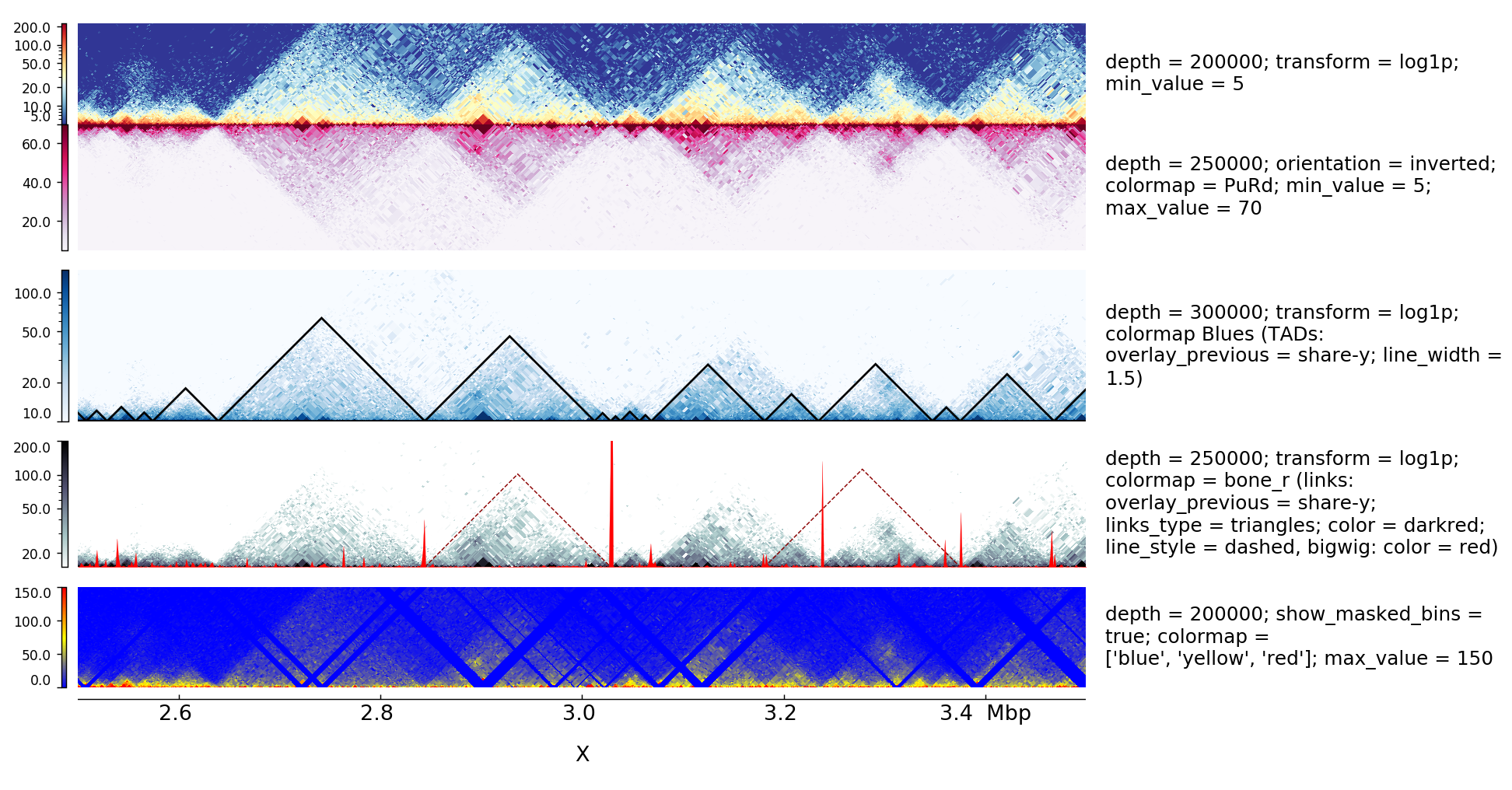pyGenomeTracks aims to produce high-quality genome browser tracks that are highly customizable. Currently, it is possible to plot:
- bigwig
- bed/gtf (many options)
- bedgraph
- epilogos
- narrow peaks
- links (represented as arcs)
- Hi-C matrices
pyGenomeTracks can make plots with or without Hi-C data. The following is an example output of pyGenomeTracks from Ramírez et al. 2017
- Installation
- Usage
- Citation
- Examples
- Examples with peaks
- Examples with Hi-C data
- Examples with Epilogos
- Examples with multiple options
- Examples with multiple options for bigwig tracks
- Examples with Hi-C data
- Possible parameters
- Adding new tracks
- External users
pyGenomeTracks works with python >=3.6.
Currently, the best way to install pyGenomeTracks is with anaconda
$ conda install -c bioconda -c conda-forge pygenometracksAlso, pyGenomeTracks can be installed using pip
$ pip install pyGenomeTracksIf the latest version wants to be installed use:
$ pip install git+https://github.com/deeptools/pyGenomeTracks.gitTo run pyGenomeTracks a configuration file describing the tracks is required. The easiest way to create this file is using the program make_tracks_file which creates a configuration file with
defaults that can be easily changed. The format is:
$ make_tracks_file --trackFiles <file1.bed> <file2.bw> ... -o tracks.inimake_tracks_file uses the file ending to guess the file type.
Then, a region can be plotted using:
$ pyGenomeTracks --tracks tracks.ini --region chr2:10,000,000-11,000,000 --outFileName nice_image.pdfThe ending --outFileName defines the image format. If .pdf is used, then the resulting image is a pdf. The options are pdf, png and svg.
Description of other possible arguments:
optional arguments:
-h, --help show this help message and exit
--tracks TRACKS File containing the instructions to plot the tracks.
The tracks.ini file can be genarated using the
`make_tracks_file` program.
--region REGION Region to plot, the format is chr:start-end
--BED BED Instead of a region, a file containing the regions to
plot, in BED format, can be given. If this is the
case, multiple files will be created using a prefix
the value of --outFileName
--width WIDTH figure width in centimeters
--height HEIGHT Figure height in centimeters. If not given, the figure
height is computed based on the heights of the tracks.
If given, the track height are proportionally scaled
to match the desired figure height.
--title TITLE, -t TITLE
Plot title
--outFileName OUTFILENAME, -out OUTFILENAME
File name to save the image, file prefix in case
multiple images are stored
--fontSize FONTSIZE Font size for the labels of the plot
--dpi DPI Resolution for the image in case the ouput is a raster
graphics image (e.g png, jpg)
--trackLabelFraction TRACKLABELFRACTION
By default the space dedicated to the track labels is
0.05 of the plot width. This fraction can be changed
with this parameter if needed.
--version show program's version number and exit
If you use pyGenomeTracks in your analysis, you can cite the following paper :
Fidel Ramírez, Vivek Bhardwaj, Laura Arrigoni, Kin Chung Lam, Björn A. Grüning, José Villaveces, Bianca Habermann, Asifa Akhtar & Thomas Manke. High-resolution TADs reveal DNA sequences underlying genome organization in flies. Nature Communications (2018) doi:10.1038/s41467-017-02525-w
(These examples are found in the examples/ folder)
A minimal example of a configuration file with a single bigwig track looks like this:
[bigwig file test]
file = bigwig.bw
# height of the track in cm (optional value)
height = 4
title = bigwig
min_value = 0
max_value = 30$ pyGenomeTracks --tracks bigwig_track.ini --region X:2,500,000-3,000,000 -o bigwig.pngNow, let's add the genomic location and some genes:
[bigwig file test]
file = bigwig.bw
# height of the track in cm (optional value)
height = 4
title = bigwig
min_value = 0
max_value = 30
[spacer]
# this simply adds an small space between the two tracks.
[genes]
file = genes.bed.gz
height = 7
title = genes
fontsize = 10
file_type = bed
gene_rows = 10
[x-axis]
fontsize=10$ pyGenomeTracks --tracks bigwig_with_genes.ini --region X:2,800,000-3,100,000 -o bigwig_with_genes.pngNow, we will add some vertical lines across all tracks. The vertical lines should be in a bed format.
[bigwig file test]
file = bigwig.bw
# height of the track in cm (optional value)
height = 4
title = bigwig
min_value = 0
max_value = 30
[spacer]
# this simply adds an small space between the two tracks.
[genes]
file = genes.bed.gz
height = 7
title = genes
fontsize = 10
file_type = bed
gene_rows = 10
[x-axis]
fontsize=10
[vlines]
file = domains.bed
type = vlines$ pyGenomeTracks --tracks bigwig_with_genes_and_vlines.ini --region X:2,800,000-3,100,000 -o bigwig_with_genes_and_vlines.pngYou can also overlay bigwig with or without transparency.
[test bigwig]
file = bigwig2_X_2.5e6_3.5e6.bw
color = blue
height = 7
title = (bigwig color=blue 2000 bins) overlayed with (bigwig mean color=red alpha = 0.5 max over 300 bins) overlayed with (bigwig mean color=red alpha=0.5 200 bins)
number_of_bins = 2000
[test bigwig max]
file = bigwig2_X_2.5e6_3.5e6.bw
color = red
alpha = 0.5
summary_method = max
number_of_bins = 300
overlay_previous = share-y
[test bigwig mean]
file = bigwig2_X_2.5e6_3.5e6.bw
color = green
alpha = 0.5
type = fill
number_of_bins = 200
overlay_previous = share-y
[spacer]
[test bigwig]
file = bigwig2_X_2.5e6_3.5e6.bw
color = blue
height = 7
title = (bigwig color=blue 2000 bins) overlayed with (bigwig mean color=redmax over 300 bins) overlayed with (bigwig mean color=red 200 bins)
number_of_bins = 2000
[test bigwig max]
file = bigwig2_X_2.5e6_3.5e6.bw
color = red
summary_method = max
number_of_bins = 300
overlay_previous = share-y
[test bigwig mean]
file = bigwig2_X_2.5e6_3.5e6.bw
color = green
type = fill
number_of_bins = 200
overlay_previous = share-y
[x-axis]$ pyGenomeTracks --tracks alpha.ini --region X:2700000-3100000 -o master_alpha.pngpyGenomeTracks has an option to plot peaks using MACS2 narrowPeak format.
The following is an example of the output in which the peak shape is drawn based on the start, end, summit and height of the peak.
[narrow]
file = test.narrowPeak
height = 4
max_value = 40
title = max_value=40
[narrow 2]
file = test.narrowPeak
height = 2
show_labels = false
show_data_range = false
color = #00FF0080
use_summit = false
title = show_labels=false; show_data_range=false; use_summit=false;color=#00FF0080
[spacer]
[narrow 3]
file = test.narrowPeak
height = 2
show_labels = false
color = #0000FF80
use_summit = false
width_adjust = 4
title = show_labels=false;width_adjust=3
[spacer]
[narrow 4]
file = test.narrowPeak
height = 3
type = box
color = blue
title = type=box;color=blue;
[x-axis]The following is an example with Hi-C data overlay with topologically associating domains (TADs) and a bigwig file.
[x-axis]
where = top
[hic matrix]
file = hic_data.h5
title = Hi-C data
# depth is the maximum distance plotted in bp. In Hi-C tracks
# the height of the track is calculated based on the depth such
# that the matrix does not look deformed
depth = 300000
transform = log1p
file_type = hic_matrix
[tads]
file = domains.bed
display = triangles
border_color = black
color = none
# the tads are overlay over the hic-matrix
# the share-y options sets the y-axis to be shared
# between the Hi-C matrix and the TADs.
overlay_previous = share-y
[spacer]
[bigwig file test]
file = bigwig.bw
# height of the track in cm (optional value)
height = 4
title = ChIP-seq
min_value = 0
max_value = 30
$ pyGenomeTracks --tracks hic_track.ini -o hic_track.png --region chrX:2500000-3500000pyGenomeTracks can be used to visualize epigenetic states (for example from chromHMM) as epilogos. For more information see: https://epilogos.altiusinstitute.org/
To plot epilogos a qcat file is needed. This file can be crated using the epilogos software (https://github.com/Altius/epilogos).
An example track file for epilogos looks like:
[epilogos]
file = epilog.qcat.bgz
height = 5
title = epilogos
[x-axis]The color of the bars can be set by using a json file. The structure of the file is like this
{
"categories":{
"1":["Active TSS","#ff0000"],
"2":["Flanking Active TSS","#ff4500"],
"3":["Transcr at gene 5\" and 3\"","#32cd32"],
"4":["Strong transcription","#008000"]
}
}In the following examples the top epilogo has the custom colors and the one below is shown inverted.
[epilogos]
file = epilog.qcat.bgz
height = 5
title = epilogos with custom colors
categories_file = epilog_cats.json
[epilogos inverted]
file = epilog.qcat.bgz
height = 5
title = epilogos inverted
orientation = inverted
[x-axis]A comprehensive example of pyGenomeTracks can be found as part of our automatic testing.
Note, that pyGenome tracks also allows the combination of multiple tracks into one using the parameter: overlay_previous=yes or overlay_previous=share-y.
In the second option the y-axis of the tracks that overlays is the same as the track being overlay. Multiple tracks can be overlay together.
The configuration file for this image is here
The configuration file for this image is here
In these examples is where the overlay tracks are more useful. Notice that any track can be overlay over a Hi-C matrix. Most useful is to overlay TADs or to overlay links using the triangles option
that will point in the Hi-C matrix the pixel with the link contact. When overlaying links and TADs is useful to set overlay_previous=share-y such that the two tracks match the positions. This is not
required when overlying other type of data like a bigwig file that has a different y-scale.
The configuration file for this image is here
Here is a table to summarize which are the parameters that can be use for each of the file_type and which is the default value:
Empty means this parameter is not used.
not set means that by default the parameter is commented.
| parameter | x-axis | epilogos | links | domains | bed | narrow_peak | bigwig | bedgraph | bedgraph_matrix | hlines | hic_matrix |
|---|---|---|---|---|---|---|---|---|---|---|---|
| where | bottom | ||||||||||
| fontsize | 15 | 12 | 12 | ||||||||
| categories_file | not set | ||||||||||
| orientation | not set | not set | not set | not set | not set | not set | not set | not set | not set | not set | |
| links_type | arcs | ||||||||||
| line_width | not set | 0.5 | 0.5 | 0.5 | |||||||
| line_style | solid | solid | |||||||||
| color | blue | #1f78b4 | #1f78b4 | #FF000080 | #33a02c | #a6cee3 | black | ||||
| alpha | 0.8 | 1 | 1 | 1 | |||||||
| max_value | not set | not set | not set | not set | not set | not set | not set | not set | not set | ||
| min_value | not set | not set | not set | not set | not set | not set | not set | not set | |||
| border_color | black | black | |||||||||
| interval_height | 100 | 100 | |||||||||
| prefered_name | transcript_name | transcript_name | |||||||||
| merge_transcripts | false | false | |||||||||
| labels | true | ||||||||||
| style | flybase | ||||||||||
| display | stacked | ||||||||||
| max_labels | 60 | ||||||||||
| global_max_row | false | ||||||||||
| gene_rows | not set | ||||||||||
| arrow_interval | 2 | ||||||||||
| arrowhead_included | false | ||||||||||
| color_utr | grey | ||||||||||
| height_utr | 1 | ||||||||||
| show_data_range | true | true | true | true | true | ||||||
| show_labels | true | ||||||||||
| use_summit | true | ||||||||||
| width_adjust | 1.5 | ||||||||||
| type | peak | fill | fill | matrix | |||||||
| negative_color | not set | not set | |||||||||
| nans_to_zeros | false | false | |||||||||
| summary_method | mean | not set | |||||||||
| number_of_bins | 700 | 700 | |||||||||
| use_middle | false | ||||||||||
| rasterize | false | true | true | ||||||||
| pos_score_in_bin | center | ||||||||||
| plot_horizontal_lines | false | ||||||||||
| region | not set | ||||||||||
| depth | 100000 | ||||||||||
| show_masked_bins | false | ||||||||||
| scale_factor | 1 | ||||||||||
| transform | no | ||||||||||
| colormap | RdYlBu_r |
Some parameters can take only discrete values.
They are summarized here:
- where:
- for x-axis: top, bottom
- orientation:
- for epilogos, links, domains, bed, narrow_peak, bigwig, bedgraph, bedgraph_matrix, hlines, hic_matrix: inverted, not set
- links_type:
- for links: arcs, triangles, loops
- line_style:
- for links, hlines: solid, dashed, dotted, dashdot
- style:
- for bed: flybase, UCSC
- display:
- for bed: collapsed, triangles, interleaved, stacked
- type:
- for narrow_peak: peak, box
- for bedgraph_matrix: matrix, lines
- summary_method:
- for bigwig: mean, average, max, min, stdev, dev, coverage, cov, sum
- for bedgraph: mean, average, max, min, stdev, dev, coverage, cov, sum, not set
- pos_score_in_bin:
- for bedgraph_matrix: center, block
- transform:
- for hic_matrix: no, log, log1p, -log
- labels:
- for bed: true, false
- show_data_range:
- for narrow_peak, bigwig, bedgraph, bedgraph_matrix, hlines: true, false
- plot_horizontal_lines:
- for bedgraph_matrix: true, false
- use_middle:
- for bedgraph: true, false
- rasterize:
- for bedgraph, bedgraph_matrix, hic_matrix: true, false
- global_max_row:
- for bed: true, false
- show_masked_bins:
- for hic_matrix: true, false
- show_labels:
- for narrow_peak: true, false
- use_summit:
- for narrow_peak: true, false
- merge_transcripts:
- for domains, bed: true, false
- nans_to_zeros:
- for bigwig, bedgraph: true, false
- arrowhead_included:
- for bed: true, false
If you are interested in adding new tracks, please see Creating_new_tracks.md.
pyGenomeTracks is used by HiCExporer and HiCBrowser (See e.g. Chorogenome navigator which is made with HiCBrowser)



